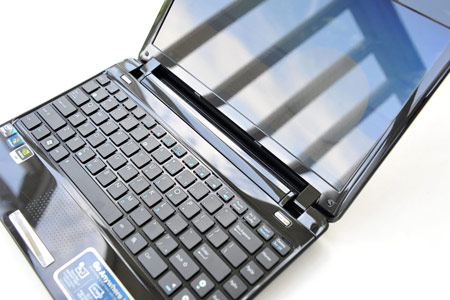User Experience
We'll mostly mirror our impressions of the Eee PC 1201N when it comes to non-performance related aspects. The chiclet keyboard is surprisingly large for a netbook, and we didn't have too much time adjusting to it from our standard 15" notebook keyboard. The keys are a tiny bit on the small side, so you can expect a typo or two from time to time, but we still maintain that the keyboard on a 12" netbook is far more able to handle lengthy typing sessions than those cramped keyboards found on 10" netbooks. If you type a great deal, and you need a netbook, a 12" one is the only way to go in our opinion.
We still wish the trackpad was a touch larger, and we wish Asus would ditch the dimples and go with a surface that's easier to use for long periods of time. A glossy pad of dimples is just strange feeling coming from practically any other standard trackpad. It's not all bad news, though; the multi-gesture support is fantastic and it definitely enhances productivity. Also, some of the editors on our team actually like the feel and this area is obviously rather subjective. Some may not mind the dimples, though we suspect most everyone will feel that the single silver trackpad button is too shallow (in terms of depression travel) and really could use a separating line. Moreover, it just needs to be larger. You shouldn't have to look at your trackpad, you should be able to just feel for it and know you're in the right place.
As far as system responsiveness is concerned, we honestly didn't notice a huge difference between the Eee PC 1201PN and the older 1201N. What's interesting is just how little has changed in terms of hardware. The 1201N had a 1.6GHz Atom 330, while the 1201PN only steps to 1.66GHz with an Atom N450. Hardly a revolutionary leap, and in real-world use, you simply cannot tell the difference. There's also 2GB of RAM (no upgrade from the original), a 250GB 5400RPM hard drive (again, no upgrade) and an Ion 2. That's the only real difference. The original 1201N had an original Ion chip, while the GeForce 201M GPU is here. We also suspect that the Ion 2 is responsible for the excess heat; we heard the fans on this machine more frequently than we ever heard the fans on the 1201N, and it definitely got a little toasty even after an hour of casual Web surfing with music streaming in the background.
But is that really a game-changer? In our opinion, it's not. What should have made the 1201PN a monumental leap over the original is the inclusion of Optimus, a feature that's destined for future Ion 2 machines but not the first wave of them. Of course, the 1201PN is in that first wave. Asus has apparently chosen to be first to the punch with an Ion 2 machine, but without graphics switching capabilities (which could switch off the discrete GPU and use an IGP in order to save power when you aren't gaming or watching HD video), there's not a lot here that's new. Ion 2 provides very minor improvements in frames per second when gaming, but it doesn't really affect too much on the video side.
The original Ion was plenty capable of handling HD video. So is the Ion 2. But why upgrade? Ion 2 tends to load up videos a touch quicker and it's better with Flash 10.1, but those are both relatively minor. Nice improvements for the new netbook buyer, sure, but not worth touting for those who already own the 1201N. We were actually shocked at how little the Ion 2 improved performance. This entire evaluation would likely have a different tone if this incarnation of Ion 2 included Optimus and if we were able to switch off the discrete GPU and save battery life. That essentially makes for an entirely new netbook experience. As it stands, the 1201PN is the 1201N in far too many ways.
Boot up took around 75 - 90 seconds before we could actually start using the machine (allowing for bloatware to load), and launching standard desktop applications took about the exact amount of time as on the 1201N. Firefox? 5-10 seconds. Steam? About the same. Loading a map in Quake Wars: Enemy Territory took around a minute. All in all, we found the hardware arrangement capable of delivering perfect normal netbook experiences; sluggish at times, but it gets the job done. The main thing to point out here is that there's been no real improvement in user experience since the 1201N, but we certainly felt the 1201N was one of the more capable netbooks of its time. In fact, the 1201N is still selling for around $470 online, making it only around $10-$20 cheaper than the 1201PN. That speaks volumes for how great the 1201N was in December of 2009, but it also tells you that the 1201PN isn't out to completely dethrone it.












